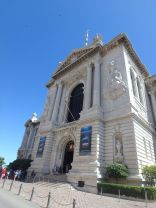- Austria
- Belarus
- Belgium
- Bulgaria
- Croatia
- Cyprus
- Czech Republic
- Denmark
- Estonia
- Finland
- France
- Germany
- Greece
- Hungary
- Ireland
- Italy
- Latvia
- Lithuania
- Luxembourg
- Malta
- Moldova
- Monaco
- Netherlands
- Norway
- Poland
- Portugal
- Romania
- Russia
- Serbia
- Slovakia
- Slovenia
- Spain
- Sweden
- Switzerland
- Turkey
- Ukraine
- United Kingdom
Oceanographic Museum

City: Monaco
Country: Monaco
Province: Monaco
Opend 1910
Species 650
The museum is home to exhibitions and collections of various species of sea fauna (starfish, seahorses, turtles, jellyfish, crabs, lobsters, rays, sharks, sea urchins, sea cucumbers, eels, cuttlefish etc.) both stuffed and in skeletal form. The museum's holdings also include a great variety of sea related objects, including model ships, sea animal skeletons, tools, weapons, etc.
An aquarium located in the basement of the museum showcases a wide array of flora and fauna. Four thousand species of fish and over 200 families of invertebrates can be seen. The aquarium also features a presentation of Mediterranean and tropical marine ecosystems.
Last visitet 2020
Musée Océanographique
Avenue Saint-Martin
98000 Monaco
Monaco
www.zootierliste.de/en/zoosmap.php?showzoo=10002069
Phone 093 15 36 00
Open : minimum 10am-6pm
Entrance fee:
- Adult 19,- €
- Child 12,- €
Annual card:
- Adult 39,- €
- Child 25,- €
History:
After having undertaken from the age of 22 (in 1870) many years of passionate oceanographic research and expeditions around the world, Prince Albert I (1848-1922, nicknamed the “learned prince navigator”) envisages for the first time in 1885, to create a marine biology laboratory in his Principality, a few months after discovering the results of his expeditions led by zoologist Alphonse Milne-Edwards. The idea matured in particular after the important success of the presentation of his scientific collections at the Universal Exhibition of Paris of 1889, with the idea of highlighting the collections that he gathered during his scientific campaigns, and disseminate new knowledge about the sea and the richness of its biodiversity. The plans for the imposing monumental and spectacular neo-baroque style palace-museum, dedicated to the Mediterranean Sea and oceanography, were drawn up at the end of the 19th century by the French architect Paul Delefortrie. The construction of the building, the first stone of which was laid on April 25, 1899, poses many technical problems to be solved over the course of twenty years (including 11 years of construction) before its inauguration and opening to the public, due to its rise on a steep rock face, facing the Mediterranean, from sea level to over 85 m high, and its respect for the integrity of the surrounding Saint-Martin gardens. The 100 m long building is mainly constructed with white stones from La Turbie and Italian limestone from Brescia for elements of particular interest such as the columns of the facade and the interior or of the monumental staircase. The Oceanographic Museum was inaugurated in 29th March 1910. Jacques-Yves Cousteau was director from 1957 to 1988. The Museum celebrated its centenary in March 2010, after extensive renovations.
DE: Dieses grosse Aquarium zeigt Lebewesen aus dem Mittelmeer und den tropischen Ozeanen. Aber auch die Geschichte der forschung im Mittelmeer.
DK: Dette store akvarium viser dyr fra middelavet og de tropiske oceaner. Ligeledes vises historien af forskningen i middelhavet.